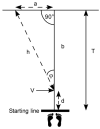Walking speed and vestibular disorders in a path integration task
- PMID: 21131202
- PMCID: PMC3042484
- DOI: 10.1016/j.gaitpost.2010.11.007
Walking speed and vestibular disorders in a path integration task
Abstract
The goal of this study was to determine if parameters of gait are related to the path integration deficits in some people with vestibular disorders. We tested normals, and two groups of vestibularly impaired people, with unilateral benign paroxysmal positional vertigo and with unilateral weakness. Each group had 20 subjects. They walked straight ahead for 7.62 m, with eyes open or closed, to the beat of a metronome at 60 beats/min, 120 beats/min and 176 beats/min. When adjusted for age and sex, normals veered significantly less and walked significantly further before veering than the unilateral weakness group; all groups veered significantly less at 120 beats/min than the slower or faster cadences. Older patients walked slightly but significantly slower than younger patients at the faster speeds. Step length did not differ among diagnostic groups. These data confirm the involvement of vestibular function in path integration, suggest a differentiation by type of vestibular impairment, and suggest some differences by cadence.
Copyright © 2010 Elsevier B.V. All rights reserved.
Conflict of interest statement
Neither author has a conflict of interest.
Figures

References
-
- Mittelstaedt H, Mittelstaedt M-L. Homing by path integration. In: Papi P, Wallraff HG, editors. Avian Navigation. Berlin Heidelberg: Springer-Verlag; 1982. pp. 290–7.
-
- Barlow JS. Inertial navigation as a basis for animal navigation. J Theor Biol. 1964;6:76–117. - PubMed
-
- Mayne R. A systems concept of the vestibular organs. In: Kornhuber HH, editor. Handbook of Sensory Physiology. Berlin: Springer Verlag; 1974. pp. 493–580.
-
- Miller S, Potegal M, Abraham L. Vestibular involvement in a passive transport and return task. Physiol Psychol. 1983;11:1–10.
-
- Cohen HS. Vestibular disorders and impaired path integration along a linear trajectory. J Vestib Res. 2000;10:7–15. - PubMed
Publication types
MeSH terms
Grants and funding
LinkOut - more resources
Full Text Sources
Other Literature Sources

